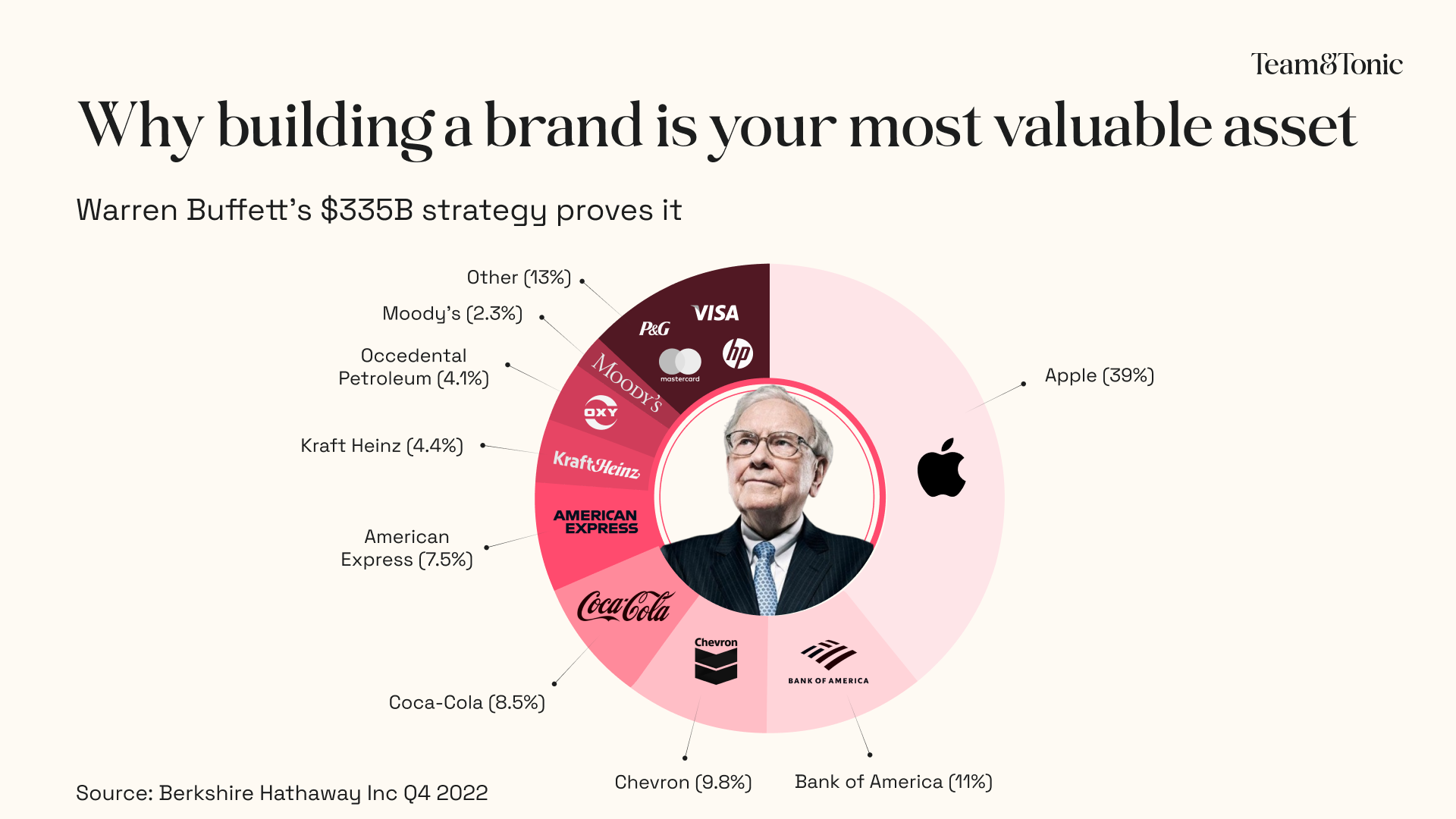89% of Startups Fail to Hire People Who Actually Deliver
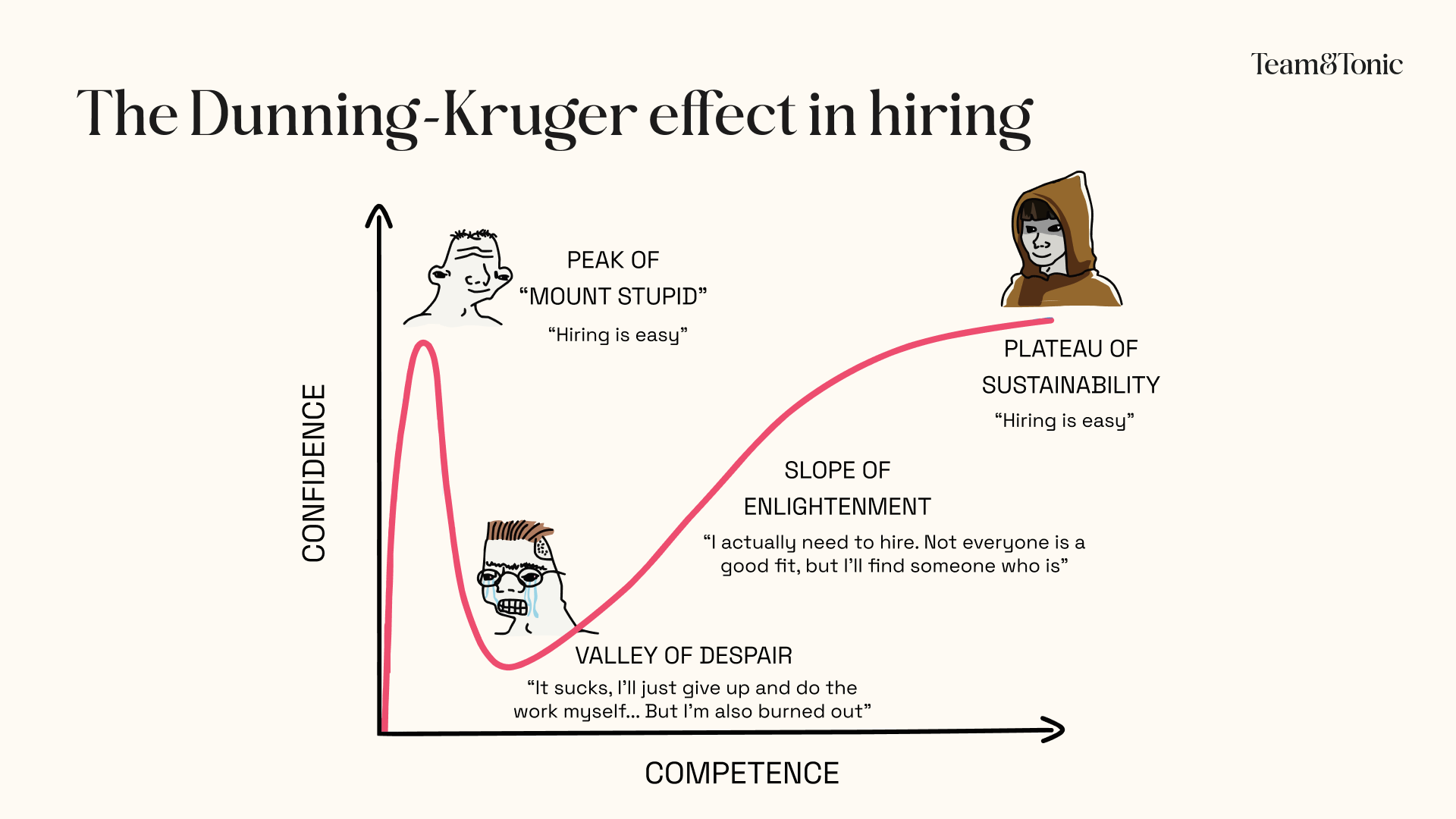
Why Most Startup Hires Fail
Hiring seems like the easiest part of a startup journey. Until you realize that it can break your company. Just let’s consider these stats:
- 23% of startups fail because they hired the wrong team. (CB Insights)
- 74% of high-growth startups fail due to premature scaling, often driven by rushed hiring decisions. (Startup Genome)
- Only 11% of new hires actually perform at a high level. (Leadership IQ)
- A single bad hire can cost up to 30% of their annual salary. (U.S. Department of Labor)
- Only 1 in 10 hires from job boards succeed. (Harvard Business Review)
Let that sink in.
For startups, hiring isn’t just another task on the to-do list.
It’s one of the biggest risks to your survival.
And yet, most founders treat it like a checklist.
I know, because I used to do the same.
I used to believe that my work requests were “easy” and could be completed “fast”.
To save some money, I also used to quickly hire freelancers who met my price expectations and assured me they could deliver on that work.
Is there anything wrong with that mindset? I didn’t think so at the time.
But here’s where that mindset took me:
- I hired people who lacked commitment
- I hired unskilled people
- I spent way more time managing than expected
- I had to redo a lot of the work myself
- I paid for deliverables I couldn’t even use
- I blew past my budget
- And after many months of this… I burned out
What Bad Hiring Actually Feels Like
Now, I talk with at least 10 founders every week about hiring designers and marketers (that’s exactly what my company, Team&Tonic, helps with).
Just by hearing their hiring expectations, I can instantly tell who’s experienced and who’s not. And every time, there’s a clear pattern:
- Experienced founders have raised multiple rounds or exited companies. They’ve made the mistakes I mention in this article, and most of them learned the hard way.
- Inexperienced founders are usually building their first startup and may have raised seed funding. They haven’t experienced these mistakes, but they’re on the brink of starting that painful journey.
It’s also much harder to discuss hiring with inexperienced founders because they have high expectations but want to hire low-cost profiles to get there. And since they haven’t felt the pain of bad recruiting yet, it’s delicate to explain why that strategy won’t work.
I totally empathize with it, because I used to be the same.
But I got to realize that there’s something harsher than someone telling you the truth. And it’s when reality shows you the truth.
I’m writing this to share my experience, hoping that you can avoid the painful mistakes I made, or at least make the journey a little smoother.
The Valley of Despair
By now, I've gotten used to the Dunning-Kruger effect (also known as the Valley of Despair).
This experience made me more humble towards life and business. Because this is exactly what I went through with recruiting. However, the process took me 2 long and excruciating years.
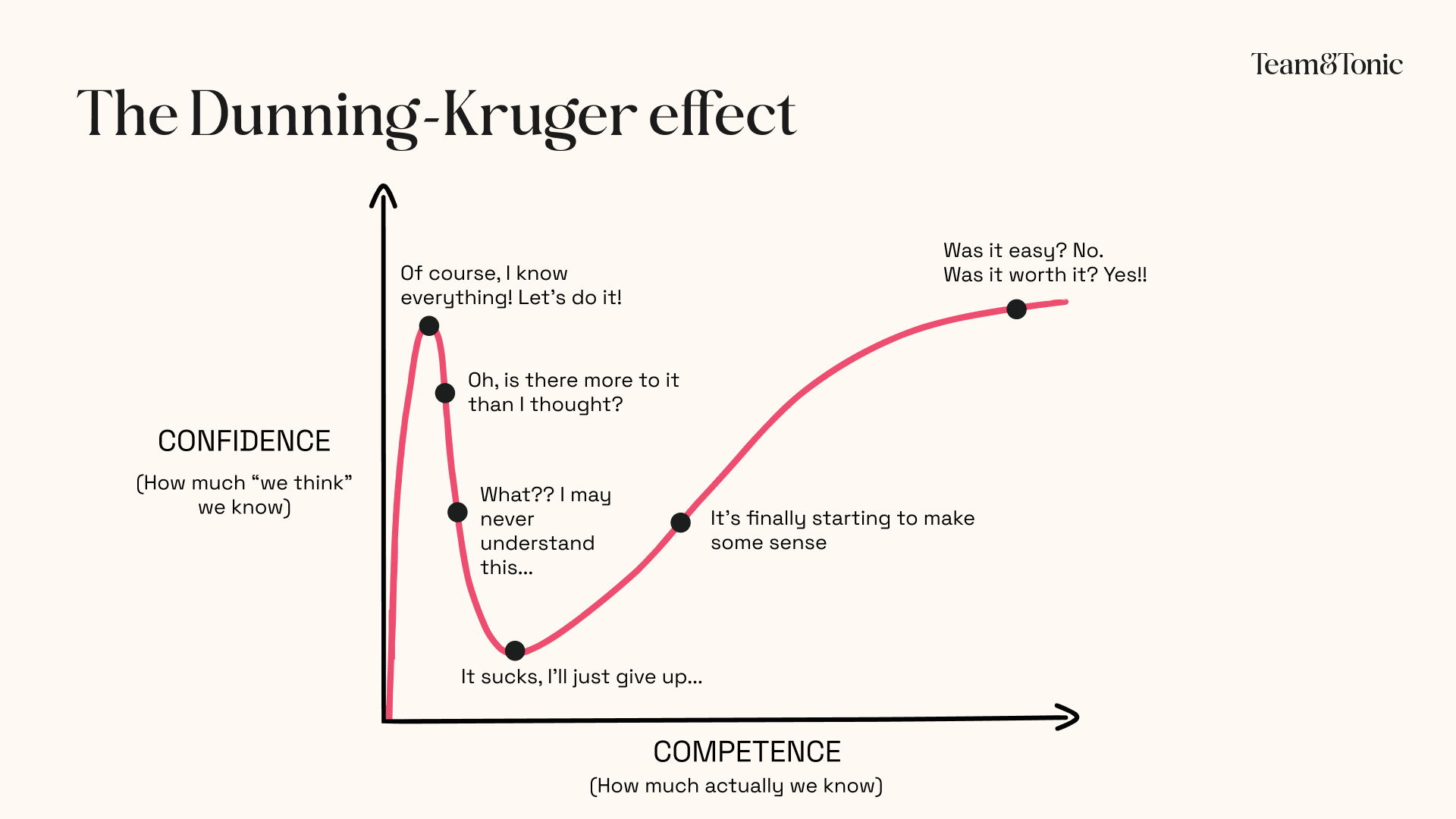
When we have a new idea or project, it’s very difficult to realize our incompetence. We get a positive rush because our idea looks like an “obvious win”. Our confidence is high while our competence is low. It’s obvious that we’ll go through a hard time (but we don’t know it yet). For me, this was: “Hiring is easy, I just need to pick someone from a freelancing platform”.
Then we realize that things are not as easy as we thought, and our confidence goes down. For me, this was: “This freelancer is not as involved as I thought and his first work is not yet aligned with what I wanted.”
But a bigger problem is yet to arrive…
For me, it went like this: “What? He tells me he is done with the work and asks for the payment while he didn’t even do half of what I expected...”.
Then, the bigger problem actually hits.
This phase was extremely long for me and it went something like this: “ok. I’ll hire someone else”, “what? it happened again?”, “ok. let me do the work myself”, “I’ll never hire anyone again”, “I’m depressed, I have too much work”, “I thought a burnout would never happen to me…”
My confidence reached the bottom and my emotions were horrible. At that point, we question ourselves, our competence, and sometimes even our feelings.
Most people end up quitting here (bottom of the Valley of Despair curve).
But great founders usually push through until they finally find some insights and get to realize things are not as easy as they thought. For me, this was: “I actually need to hire. I now realize that most freelancers are not a fit. So how can I filter them out?”.
We finally embrace the new reality and work towards a happy outcome.
For me, that moment was: “This took work, but now I have a process to consistently hire freelancers who deliver exactly what I expect. The work is exceptional, and collaborating with them is great.”
My recruiting journey truly looked something like this…

As a founder, I’m sure you can think of at least one event in your life where this happened to you.
And if it hasn’t happened yet, sorry to say, it probably will. When it does, don’t be too hard on yourself. It’s part of the process.
Now, if you’ve decided to handle recruiting yourself, the real questions are: How fast will you learn? And will you keep going once you hit bottom?
My hope with this article is to help you reach the best recruiting outcome while avoiding most of my mistakes (and the burnout).
Side note: Throughout this process, I personally vetted over 10,000 designers and marketers, and I built a team that vetted over 120,000 profiles. My team filters hundreds of profiles every day. I got to realize that only 0.8% of freelancers were truly a good fit for my projects. And I had to reject 99.2%, either because of their skills, attitude, commitment, or communication.
Why 99.2% of Candidates Won’t Work For Your Company?
When you’re looking to hire the right person for your company, you certainly have an idea of who that right person is.
However, do you have an idea of who that person is not?
It’s important to list this because they’ll represent 99.2% of your candidates.
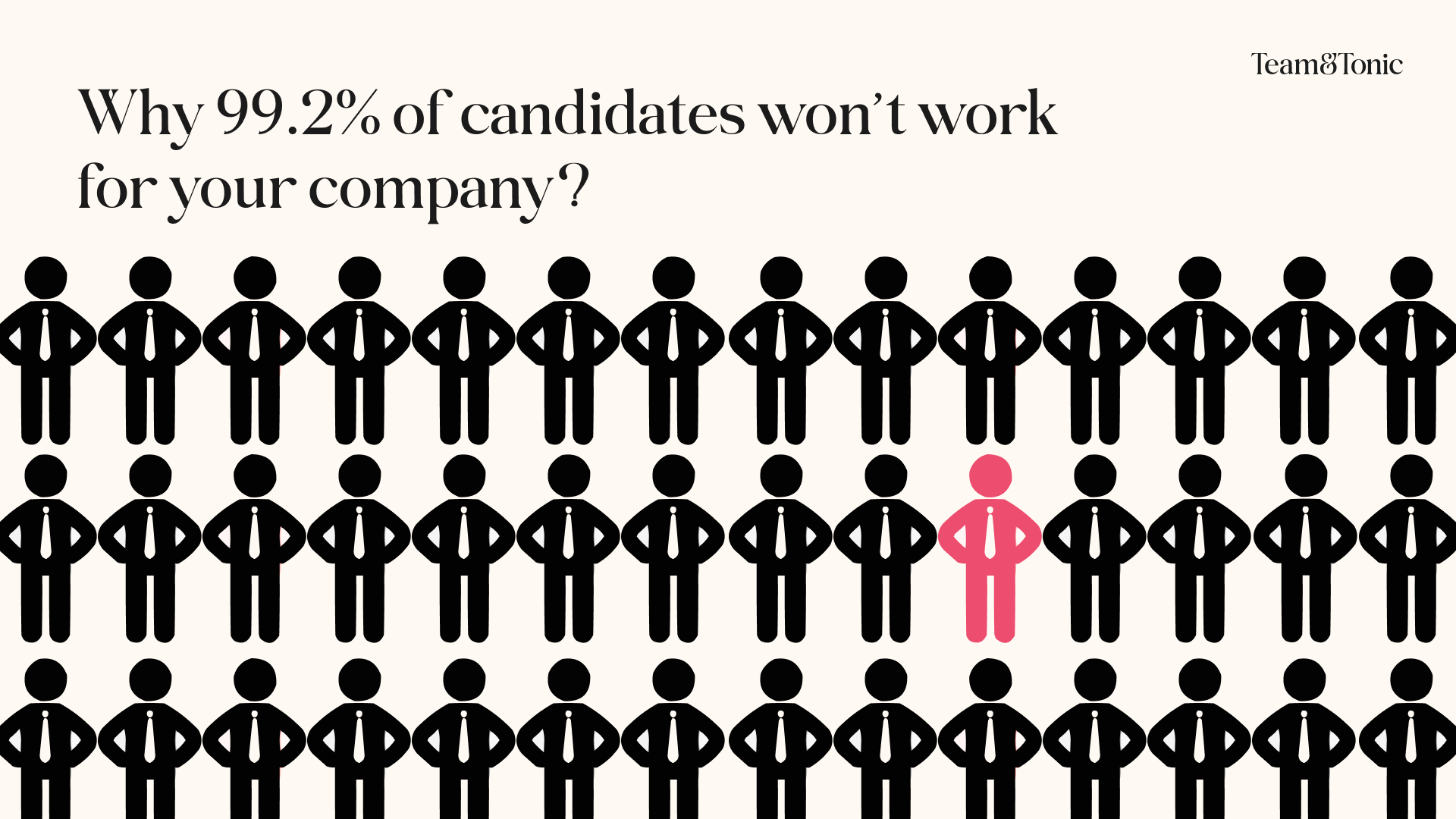
So here’s who that person is not:
- A person who waits to be told what to do
- A person who’s not committed to their work
- A person who’s inflexible and resists iteration
- A person who can’t take constructive criticism
- A person who’s easily overwhelmed by ambiguity
- A person who disappears in moments of pressure
- A person who doesn’t propose proactive solutions
- A person who blames others when things go wrong
- A person who lacks curiosity and doesn’t ask questions
- A person who expects to get feedback on every tiny detail
- A person who tells you that the job is done while it’s clearly not
- A person who is just here to take the money for the hours done
- A person who says “yes” to everything but delivers nothing meaningful
- A person who treats freelance work like a side hustle, not a commitment
The list could go on.
Now, can you clearly see why 99.2% of people tick at least one of these boxes?
You may be thinking about someone who’s currently within your team?
You might tell yourself it’s fine because the person is “nice” or “cheap.” But have you considered your own hourly rate and the time you spend giving feedback? Or the opportunity cost of not focusing on more important things?
If you do, you may realize that your “cheap” and “nice” hire is actually expensive and not so nice.
{{banner}}
How to Find the Best of the Best?
Let’s put our probabilities in perspective: 99.2% VS. 0.8%.
What are the different strategies we can use to filter out those 99.2%?
1. Blind-picking
Imagine you’re hiring a freelancer.
You go on a freelancing platform that accepts everyone. By “everyone,” I mean people who’ve never had a job, got fired for bad behavior, or watched a few YouTube tutorials and now call themselves “designers.”
You scroll.
Skim a few portfolios.
Have a quick chat.
And make a quick hire.
Do you really believe you picked the best person?
Deep down, you probably know the answer: no.
If you’re blind-picking people, do you truly believe you’ll succeed?
Yet this is what most startups do.
And it’s one of the quiet killers behind why 90% of startups fail.
So what do the 10% of successful ones do differently?
They don’t pick from the crowd.
They either hunt or they filter.
2. Hunting
If a person is extremely talented, they’ll always be recommended and, as a consequence, they’ll always be in demand.
Therefore, they aren’t looking for jobs.
That means conventional hiring channels like job boards or inbound applications have an extremely high probability of not landing the best people.
So to work with them, you have to go outbound.
You need a process to identify the true signal of the greatest talents in a sea of noise.
Once you find them, you study their work. Then you reach out.
But let’s be real: Hunting takes time, focus, and it’s limited to your close network or your ability to research these people.
And when you’re trying to move fast, this becomes nearly impossible to do alone.
The other option? Let the crowd come to you.
3. Filtering
Post the role.
Watch applications coming in.
But here’s the catch: you must build a ruthless filtering system.
Every candidate needs to go through a multi-layered funnel:
- Have they proven their skills?
- Have they ever shown signs of a bad attitude?
- Do they care about outcomes or just completing tasks?
- Can they communicate clearly and think critically?
It’s a numbers game for which you can expect 1–5 months to find one person who’s truly right.
How to attract the best?
Therefore, effective recruitment leverages identical skills to effective marketing and sales:
- Defining the job description (similar to identifying your avatar)
- Writing the job post (similar to writing a landing page or posting)
- Reaching out or attracting talent (similar to outbound or inbound)
- Maximizing application quality (similar to maximizing lead quality)
- Interviews (similar to sales calls)
- Employee onboarding (similar to customer onboarding)
To land the best people, you need to leverage your marketing and sales ability.
For example: When writing the job post, use powerful copy that resonates deeply with your ideal candidate. If you’re not sure what would resonate, talk to top performers in that role. Ask them what their dream job looks like, then reflect their words and priorities in the job description.
Therefore, here’s the obvious truth: if you want to hire the best 0.8%, you can’t act like the 90% of startups. You need a system that lets you either hunt the best or filter out the noise at scale. That’s what separates the ones who scale from the ones who stall.
Why 90% of Startups Still Blind-pick Freelancers or Even Employees?
There are 2 reasons.
One that involves founders and the company culture itself.
The other involves the market.
Let’s start with the most difficult to hear.
Reason #1: The company culture
If this concerns you, sorry to be this straightforward.
I know that it’s better to read it than to live it.
Insecure leaders surround themselves with “yes people.”
Effective leaders surround themselves with people who challenge them. They also find and hire people who are much smarter than they are. Especially in areas in which they are weak.
Reed Hastings, the legendary founder of Netflix, puts it another way.
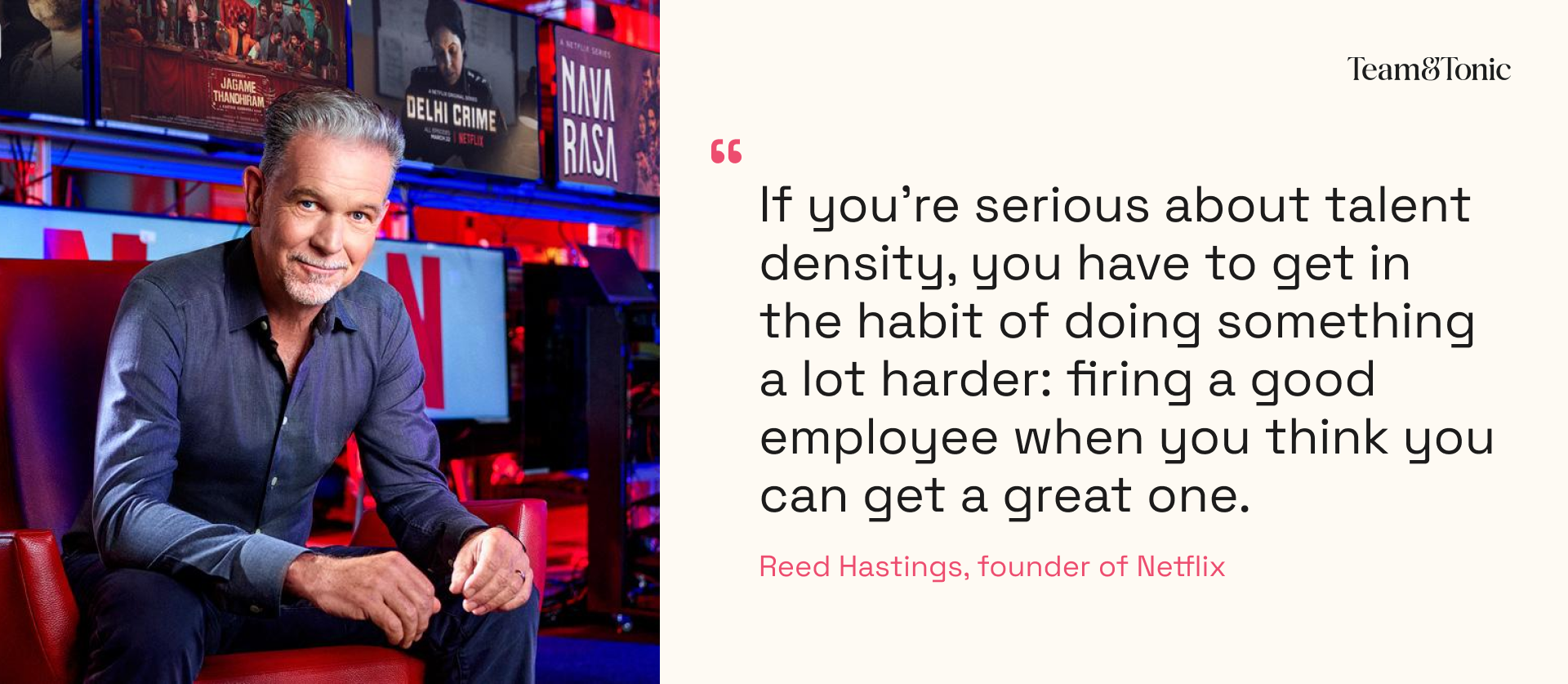
One of the reasons this is so difficult in many companies is that business leaders keep telling their employees or even freelancers, “We are a family”.
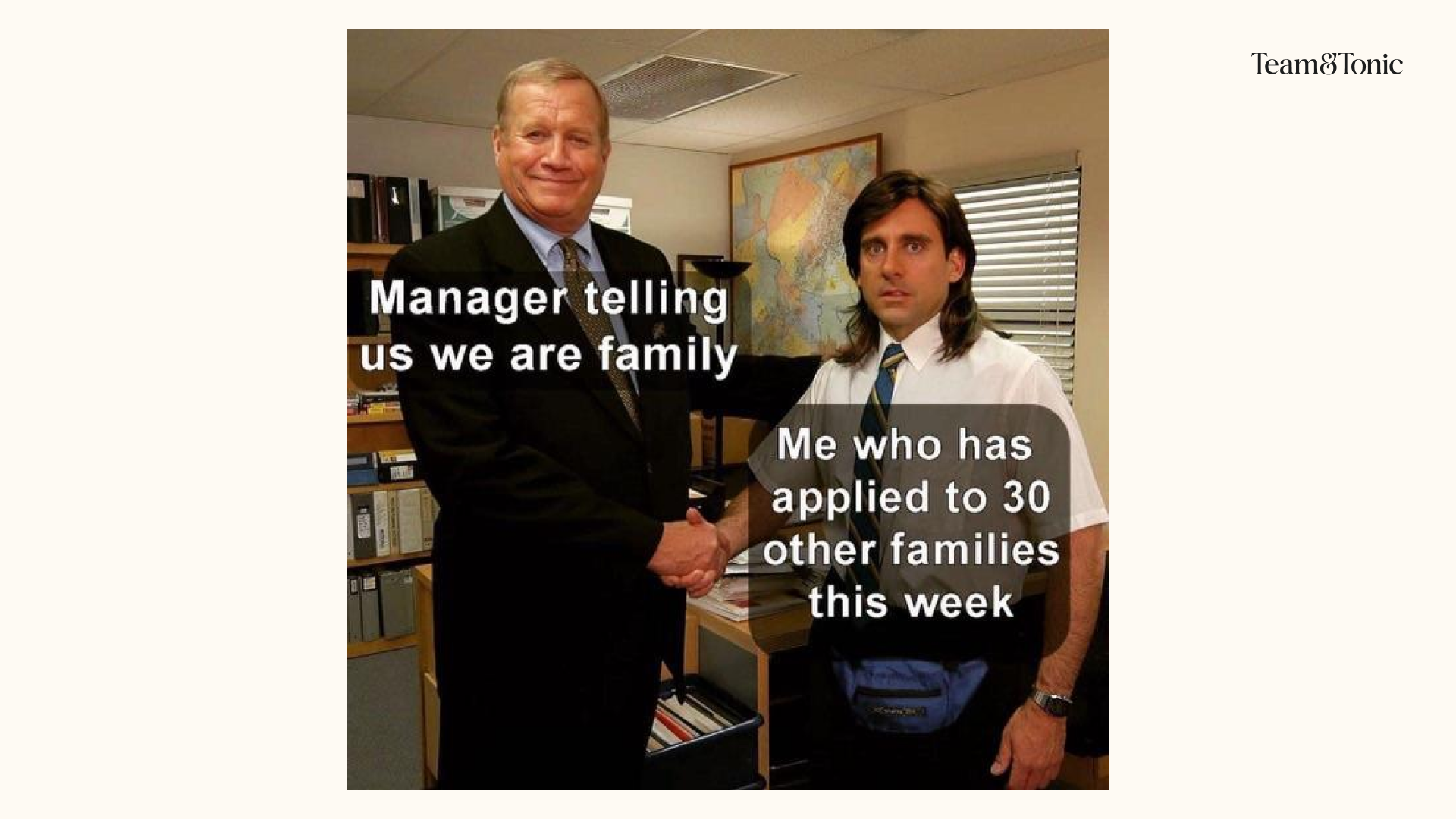
But a high-talent-density work environment is not a family.
On a basketball team, the players have great relationships. These players are really close. They support one another. They celebrate together, console one another, and know each other’s plays so well that they can move as one without speaking.
But they are not a family.
The coach swaps and trades players in and out throughout the year in order to make sure they always have the best player in every position.
Like the basketball coach, it’s your job to put the best people you can find on the team.
That means taking people off the team who aren’t the best you can possibly find.
How do you know whether someone’s not cutting it?
“When there’s doubt there’s no doubt”.
If you’re asking yourself if they’re the right fit, remember that 99.2% of the time, they’re not.
A-players make it obvious that they’re A-players.
Reason #2: Recruiting is a long-term game
Given everything I have mentioned, here’s something you need to accept: building a team of the best 0.8% is a long-term game because talent self-replicates and lasts a lifetime.
Let me tell you 2 stories.
Stripe was desperately hunting for someone to lead their product department.
They had their eye on a stellar executive but couldn’t convince her to join them. But they persisted. Spending three years, doing hundreds of outreaches, dozens of dinners and phone calls. Eventually, 36 months later, she said yes and joined Stripe.
What happened next? She built one of the world’s leading product teams, recruiting 1000+ rockstars and helping Stripe clear its $100B valuation.
There are three things worth taking away from this:
- The impact a true rockstar can have is enormous.
- It always makes sense to keep persisting until you land them. Even if it takes years.
- Great people attract more great people. Teams tend to self-replicate.
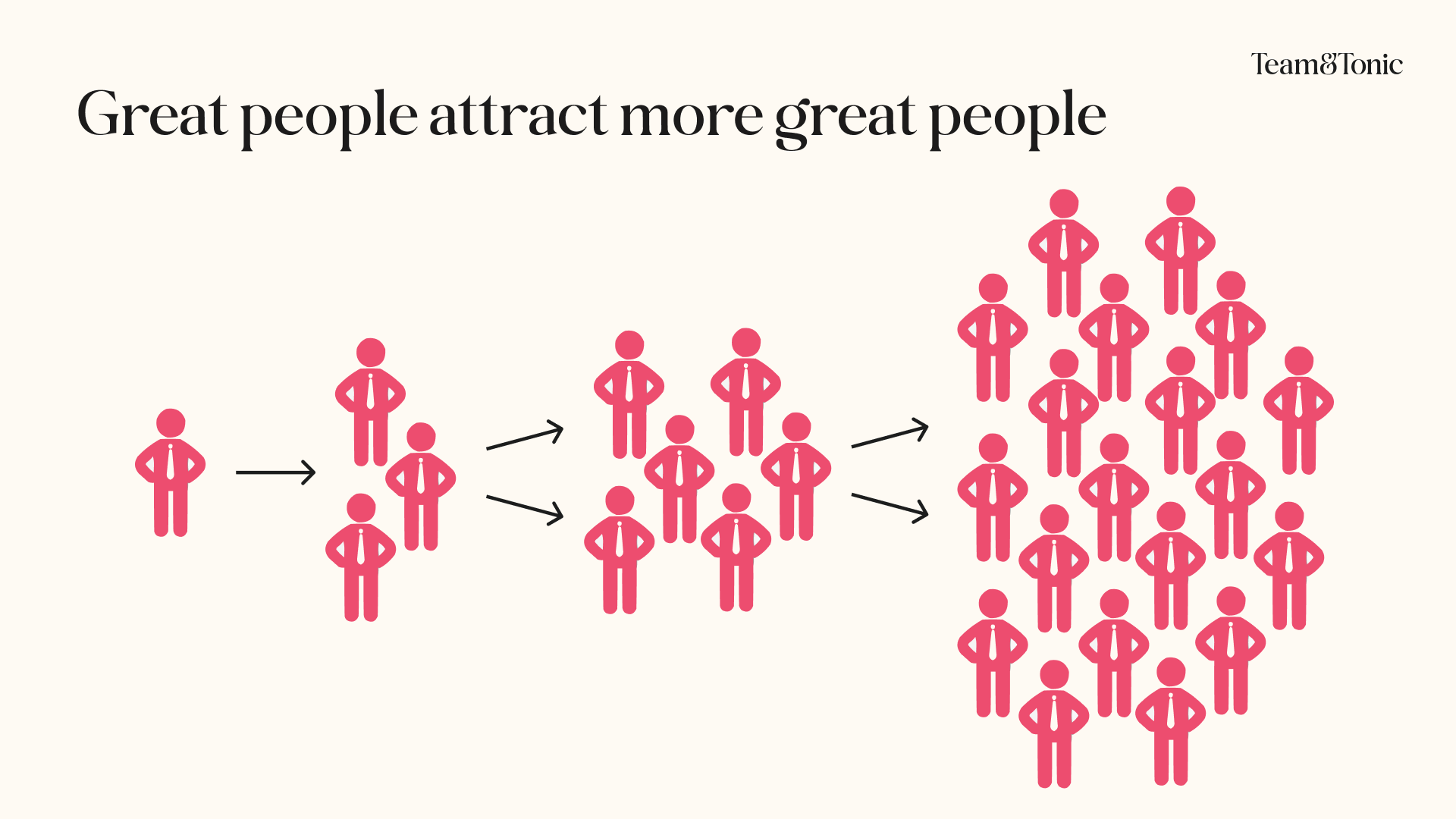
Everyone we hire is not just that person, it’s every future hire they will make or influence.
A great hire can lead to hundreds more (like in the Stripe example).
A bad hire means the opposite. So be careful.
My second story…
Frank Slootman, ex-CEO of Data Domain, ServiceNow and Snowflake (which he took to $1B+, $10B+ and $100B+ respectively), is said by many to be the world’s best living CEO.
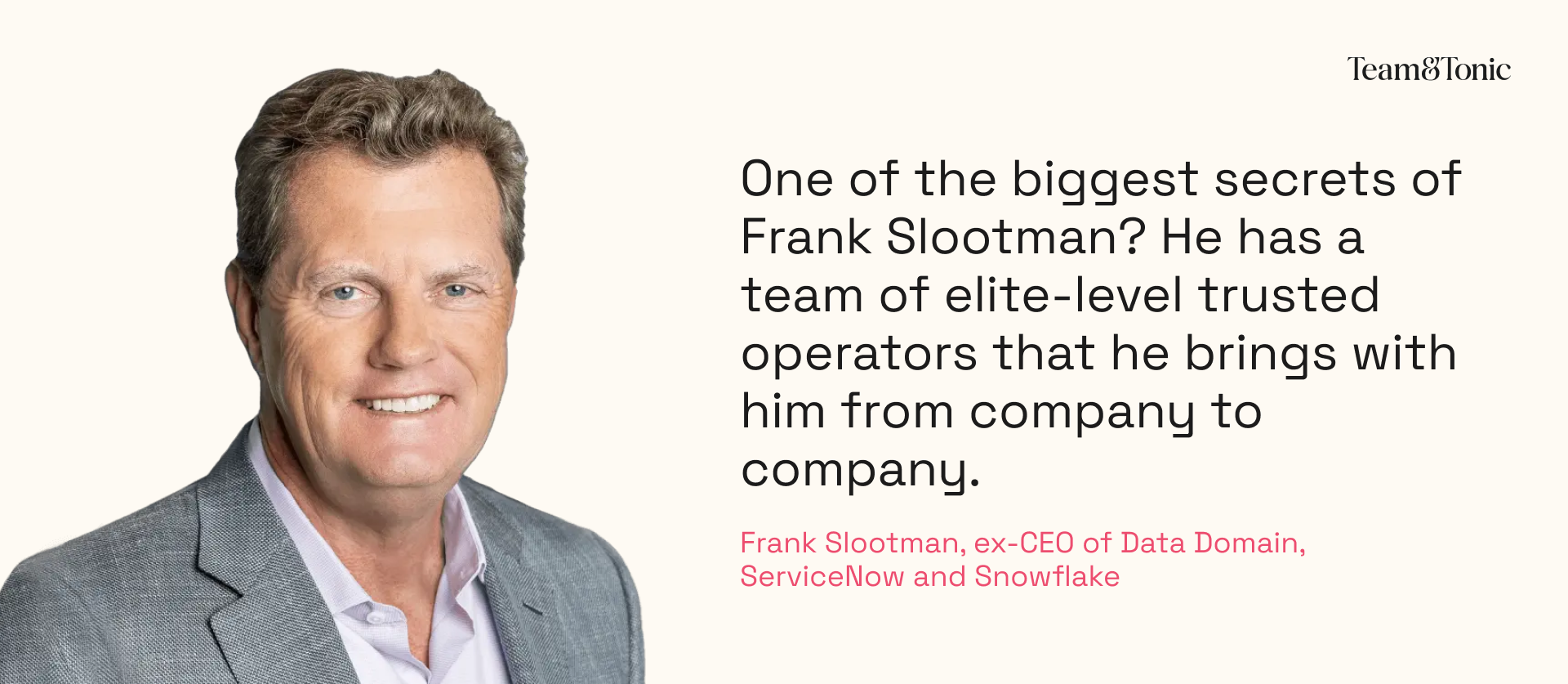
One of his secrets? He has a team of elite-level trusted operators that he brings with him from company to company.
This is a critical point because your best people will transcend your company. If you play your cards right, they’ll be with you for decades. Even for life.
The best entrepreneurs know this and play the recruitment long game.
They know that it can take 3 months, 18 months, or multiple years to get a rockstar on their team.
Work with the best 0.8%
I’ve told you the truth in this article. No fluff, no sugarcoating.
And the conclusion? It’s probably not as nice or easy as you hoped. Because it isn’t.
Great businesses aren’t built overnight (contrary to what’s seen on social media).
But let’s be real: in the startup world, there are some limitations to everything I described earlier:
The startup environment changes fast. It’s fast-paced. You cannot build a recruiting team slowly and wait for multiple months. Because speed and runway matter.
On top of that, work is chaotic and unpredictable. You may think you need a UX designer for tomorrow, but you actually need a marketing strategist first.
That’s why I created a network of the best 0.8% of freelance designers and marketers, so startups can skip the painful recruiting cycle and work immediately with exceptional talent.
{{banner}}
The Team&Tonic network was carefully built over the years by doing everything I’ve shared above. Finding A-players takes time, rigor, and systems. We’ve done the hard work so founders don’t have to spend months (or years) getting the right people on board.
You can start on a flexible freelancing agreement, and bring them in-house once you love working with them.
If you’re feeling stretched thin, doubting your design or marketing hires, or your startup’s needs have just suddenly ramped up, now’s the time to upgrade.
Get the right person for every task and start working for as little as 5 hours. You’ll get matched with an exceptional freelancer who is committed to your success.
Now, there’s no excuse for not working with the best of the best.
Join our newsletter to get our latest insights
Related Articles










